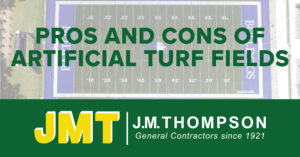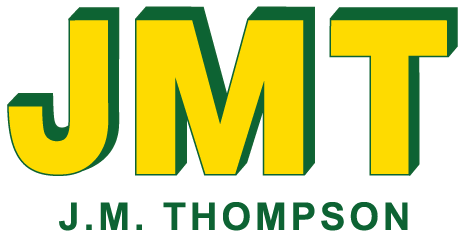A trend that is continuing to gain momentum is artificial turf fields. From NFL stadiums to local parks, artificial turf fields are becoming a popular choice and seem to be replacing natural grass fields at a rapid rate.
Artificial turf fields are composed of polyethylene plastic grass and a “crumb rubber” usually made of up to 10,000 recycled tires in a single field.
Although artificial turf fields have gained traction for several municipalities and sport franchises, some are still skeptical of their safety and sustainability. There are several pros and cons of artificial turf fields and understanding them can help you choose the best option for your next turf project!
Pros of Artificial Turf Fields
There are many upsides to having an artificial turf field instead of natural grass, including:
- Less maintenance
Artificial turf fields are a more expensive option than natural grass upfront, but the maintenance to maintain them is small in comparison to grass fields. Typically, an average artificial soccer or football field would cost $800,000 to $1 million. However, you get this money back in the long-run since there is no need to water, cut, fertilize, or spray pesticides on the field each season. This cuts back on costs, energy, and time to upkeep, leaving more time to play! Most often, owners can break even within five to seven years of installing an artificial turf field.
- Weather proof
Artificial turf fields are not weather dependent. You do not need sun or rainwater to grow the grass and the field never gets muddy. Underneath the artificial turf is a layer of crushed gravel that helps with stormwater drainage. Gravel is porous and helps retain excess stormwater. Because of the effective drainage system, this allows more games to be played on the field without weather delays affecting it.
- Field Consistency
Artificial turf fields provide a consistent playing field. Natural grass can have divots, patches of thick grass, and patches worn down by use. This could lead to more safety hazards and injuries. With artificial turf fields, the field is always even and the pitch remains the same no matter the wear and tear. This keeps athletes safe and provides a level playing field for all participants.
- Environmentally Friendly
Some claim that artificial turf fields offer an environmentally friendly aspect. The field does not have to be watered, it uses recycled material for the crumb rubber, and does not require harmful chemicals like pesticides to help grow the grass.
Cons of Artificial Turf Fields
Although there are several positives to installing an artificial turf field, there are potential downsides to consider, including:
- Reduced flexibility
Because the artificial turf has lines embedded in the field weave, it can be a challenge to use as a multi-purpose field. Traditional grass fields can have painted lines that can be changed when needed, but with artificial turf, it can be expensive to change the lines of the field. To work around this, some owners have installed different color lines to indicate different sports’ fields on the same turf.
- Heat Hazard
Due to the rubber crumb, artificial turf fields can be a heat hazard in summer months. On a 98 degree day, the field temperature can rise up to 120 degrees making it less comfortable to play on. Studies have shown that synthetic turf material can be up to 37 degrees higher than the air temperature. This can make it harder for athletes to stay hydrated during the heat of the day.
- Safety Concerns
Although the evenness of the field can provide safety measures in some areas, it leads to other safety issues that are not a concern with natural grass. Since there are 4-6 inches of packed stone underneath every artificial turf field, and due to the abrasive texture of the plastic grass, this can lead to harmful impact injuries. Instead of falling on a softer surface like dirt and grass, players may end up with more injuries like concussions. However, studies are being done to minimize this safety issue and artificial turf fields now undergo g-max testing that tests the impact of the field in order to make it safer. Many artificial turf fields now come with shock pads that can be installed underneath the turf weave, making for a plusher surface and a safer playing field.
Experience with Artificial Turf Fields
J.M. Thompson, general contractors in NC, have become subject matter experts on artificial turf fields. We have constructed 20+ artificial turf fields for sporting facilities and municipalities. One is Barton College’s artificial football field in Wilson, NC. This artificial turf field was the first one to be installed in Wilson, NC. The field is utilized for football, men and women’s soccer, and men’s and women’s lacrosse for both Barton College and the City of Wilson. Another project that has sharpened our expertise of artificial turf fields is Pleasant Park in Apex, NC. This 92-acre park for the Town of Apex includes six multi-purpose artificial fields. In Holly Springs, J.M. Thompson was part of the Parrish Womble Park renovation where we installed the largest artificial turf field in NC totaling three football fields in length. These multi-purpose fields can be used for several different town sports and events.
Why Choose Artificial Turf? Why Choose J.M. Thompson?
A family-owned and operated company, J.M. Thompson, general contractors and construction managers, brings together vast construction knowledge to each project they take on. The team is comprised of experienced professionals in the industry, as the company is only as good as its employees. Artificial turf fields offer a wider range of benefits for players and owners alike. For more durability, longevity, and consistency, consider installing artificial turf for your next project. Our deep parks and recreation portfolio shows that we are experts at constructing both natural and artificial fields. We will help transform your natural grass fields into long-lasting artificial fields.

